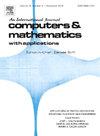Developing PDE-constrained optimal control of multicomponent contamination flows in porous media
IF 2.9
2区 数学
Q1 MATHEMATICS, APPLIED
引用次数: 0
Abstract
This paper develops a robust and efficient PDE-constrained optimal control model for multicomponent pollutions in porous media, which takes into account nonlinear multi-component contamination flows of groundwater. The objective of the pollution optimal control is to identify the optimal injection rates from the top part boundary of domain, which can minimize the least squares error between the concentrations that are simulated and the allowable observed concentrations at observation sites, combining with the affection of costs associated with reducing emissions at injection locations. To discrete the constrained governing system of nonlinear multi-component flows, the splitting improved upwind finite difference scheme is developed for multicomponent PDEs system involving nonlinear chemical reactions of multicomponent pollutants and the pollutant injected rates on the upper part boundary. We employ the differential evolution (DE) optimization algorithm to solve the optimization. We numerically demonstrate the effectiveness of our model by analyzing the flow simulation on a simple geometric aquifer and identifying the optimal injection rates by minimizing the concentration derivation and the abatement costs. We also investigate the simulation of the contamination flow in a more realistic-shaped aquifer, which further validates our model's robustness and efficacy. The developed PDE-constrained control model and algorithm can be applied to applications of groundwater pollution control.
开发多孔介质中多成分污染流的 PDE 约束优化控制
本文针对多孔介质中的多组分污染建立了一个稳健高效的 PDE 约束优化控制模型,该模型考虑了地下水的非线性多组分污染流。污染优化控制的目标是确定域顶边界的最佳注入率,使模拟浓度与观测点允许观测浓度之间的最小二乘误差最小,同时考虑减少注入点排放的相关成本。为了离散非线性多组分流动的约束系统,我们针对多组分 PDEs 系统开发了分裂改进的上风有限差分方案,该方案涉及多组分污染物的非线性化学反应和上部边界的污染物注入率。我们采用微分演化(DE)优化算法来解决优化问题。我们通过分析简单几何含水层上的流动模拟,并通过最小化浓度推导和减排成本确定最佳注入率,从数值上证明了我们模型的有效性。我们还研究了形状更逼真的含水层中的污染流模拟,进一步验证了模型的稳健性和有效性。所开发的 PDE 受限控制模型和算法可应用于地下水污染控制领域。
本文章由计算机程序翻译,如有差异,请以英文原文为准。
求助全文
约1分钟内获得全文
求助全文
来源期刊

Computers & Mathematics with Applications
工程技术-计算机:跨学科应用
CiteScore
5.10
自引率
10.30%
发文量
396
审稿时长
9.9 weeks
期刊介绍:
Computers & Mathematics with Applications provides a medium of exchange for those engaged in fields contributing to building successful simulations for science and engineering using Partial Differential Equations (PDEs).
 求助内容:
求助内容: 应助结果提醒方式:
应助结果提醒方式:


